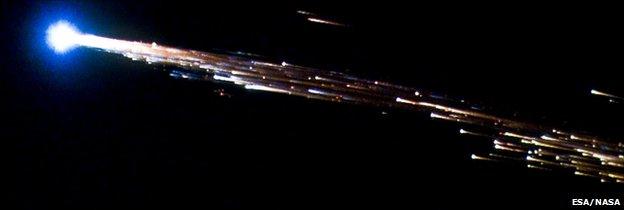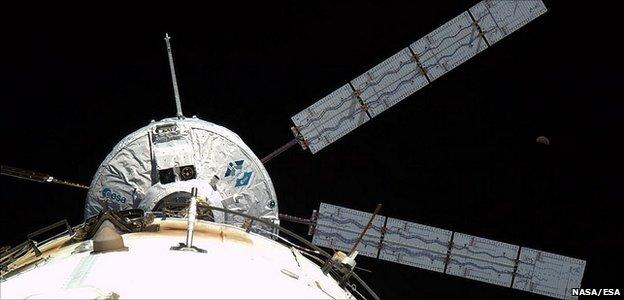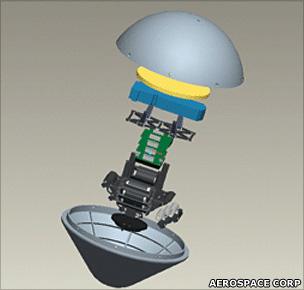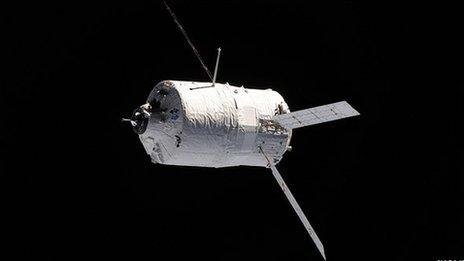Revealing the secrets of falling to Earth
- Published
- comments

The return of Jules Verne in 2008 was subjected to a detailed observation campaign
Late on Tuesday (GMT), a huge fireball will streak across the skies over the Pacific Ocean.
Not many will get to see it; it will be over an uninhabited part of the world, and ships and planes have been warned to steer clear of the area.
The event is the return from orbit of Europe's space freighter, ATV-Johannes Kepler, external.
It has completed its mission at the International Space Station (ISS) and it's now time to come home.
The freighter took up more than seven tonnes of fuel and other supplies to the orbiting outpost, but for its return it has been packed with the platform's rubbish.
Little of the ship or this waste is actually expected to make it all the way to the surface of the Pacific Ocean. Most will simply vaporise in the intense heat generated during the descent through the atmosphere.

Johannes Kepler has spent the past four months attached to the back of the ISS. It has been filled with all the rubbish from the space station for its destructive return to Earth
This is the second time a European freighter has made the fall to Earth. In 2008, the maiden vessel, Jules Verne, did exactly the same thing.
On that occasion, external, its brilliant path across the sky was observed by US and European space agency research planes, external. Their observations produced some remarkable video and some of the most detailed analysis ever done on what happens to a spacecraft when it breaks up on re-entry.
That analysis is still ongoing; scientists continue to debate precisely which components broke away, and when. But they have a broad picture.
"The break-up created a big jigsaw puzzle of pieces," said aircraft observing campaign principal investigator and meteor astronomer Peter Jenniskens of the Seti Institute and Nasa Ames.
"We analysed the colours of those fragments to figure out their composition. The two participating airplanes provided depth perception to trace the fragment paths," he told BBC News.
Jules Verne was a 13-tonne object when it came back. It engaged the top of the atmosphere at an altitude of about 120km, travelling at about 7.6 km/s.
As it plunged deeper and deeper, it started to tumble. The solar panels were the first obvious casualties - ripped from their mountings about 83-84km up.
As the ship progressed downwards, it got hotter and brighter, creating a multi-coloured fireball - a shower of blues, yellows and oranges.
Spectrometers on the "chase planes" picked up in this light shower the signatures of the various materials in the ship burning off.
"Some fragments show paint peeling off; others show aluminium melting. We even see the main lithium batteries fall apart, creating four dots of bright pink light," said Jenniskens.
If you watch the video on this page, you can pick out a couple of key moments that have generated much debate inside the research team.
The first is a sudden brightening at about 6" into the video. This is a major fragmentation event at 75km altitude.
The ship lets go, severing into two big pieces. It breaks into three large chunks shortly afterwards.
Interestingly, the major fragmentation event does not appear to be the result of a fuel explosion.
"It looks as though it should be," said Jenniskens, "but if it were, there would have been a lot of carbon and hydrogen visible to the instruments."
Watch also for "the nose" at about 1'09".
You'll see one bright item move ahead of the debris field. It's very distinctive, and scientists detected the presence of lithium; a spent battery, perhaps?
Jules Verne's debris train eventually disappears from view at about 31km altitude. The team cannot say for sure how much material survived to the surface, but it's thought very little splashed down.
"The results should provide engineers with better tools to understand the re-entry physics of such complicated spacecraft," said project manager Jason Hatton of Esa's Estec facility in Holland.
"That in turn will feed back into better spacecraft design, especially of thermal protection systems, or heatshields, and an improvement in the models that are used to assess debris footprints."
On occasions, spacecraft or old rocket stages will come back to Earth in an uncontrolled manner over land, and safety concerns demand that we have a good idea of where chunks of metal might hit the ground.

The Aerospace Corporation's REBR is about 30cm tall and weighs just a few kilograms
Kepler's return will not be subjected to the same level of analysis.
The type of observation campaign mounted for Jules Verne takes much preparation and analysis. Instead, Kepler has a "blackbox" aboard.
This Re-Entry Breakup Recorder (REBR) will record temperature, acceleration, rotation rate, and other data as Kepler tumbles through the atmosphere.
In the latter moments of re-entry, it should break free from the main debris cloud, right itself and then make an Iridium satellite phone call to downlink everything it has learnt.
The REBR is not intended to survive its impact with the ocean, although - remarkably - the one fitted to the returning Japanese space freighter, HTV-2, in March, did.
It bobbed about on the water for some hours, external. The unit has been developed by the American Aerospace Corporation, external, but Europe is developing its own version.
In future, many spacecraft and rockets will carry these devices, especially as they incorporate more composites. There is very limited data on how these materials behave when they fall to Earth.
Recommended: There is an interesting behind-the-scenes video of the Jules Verne descent, external which ties together what was happening inside the chase planes with what the observers were seeing through their windows.
- Published5 May 2011

- Published17 February 2011